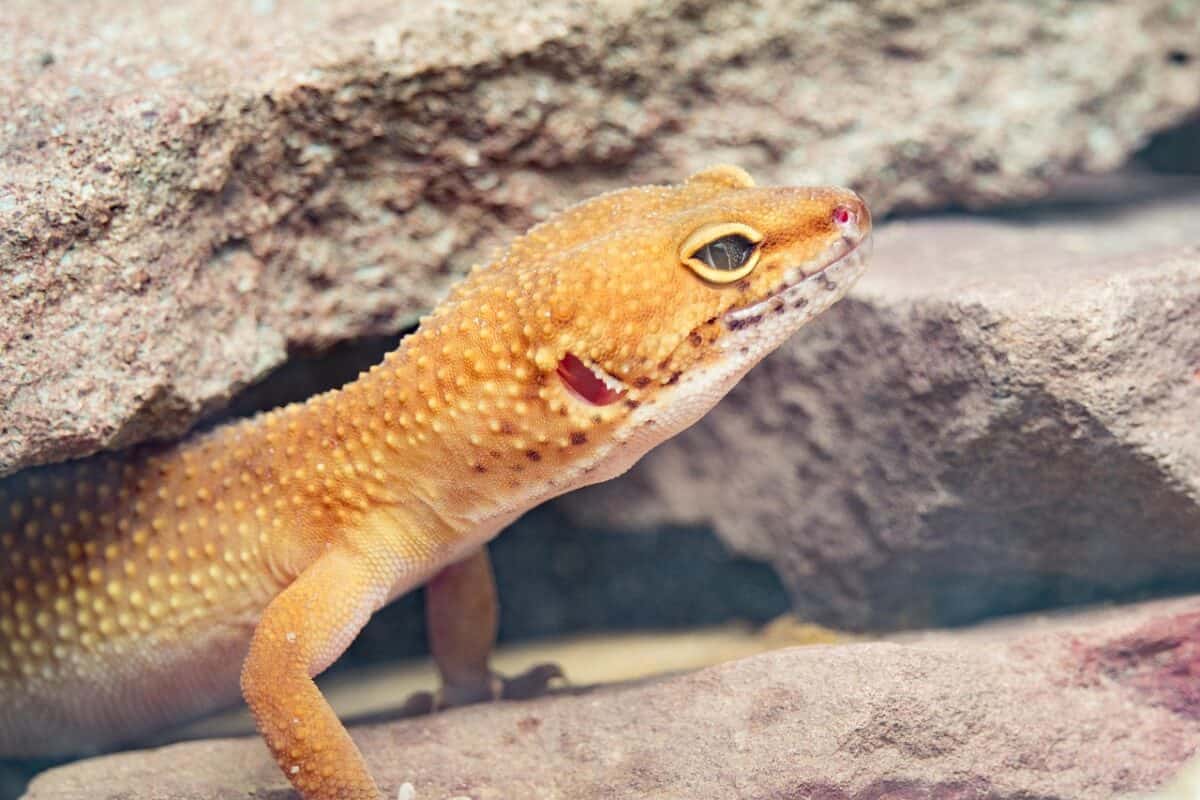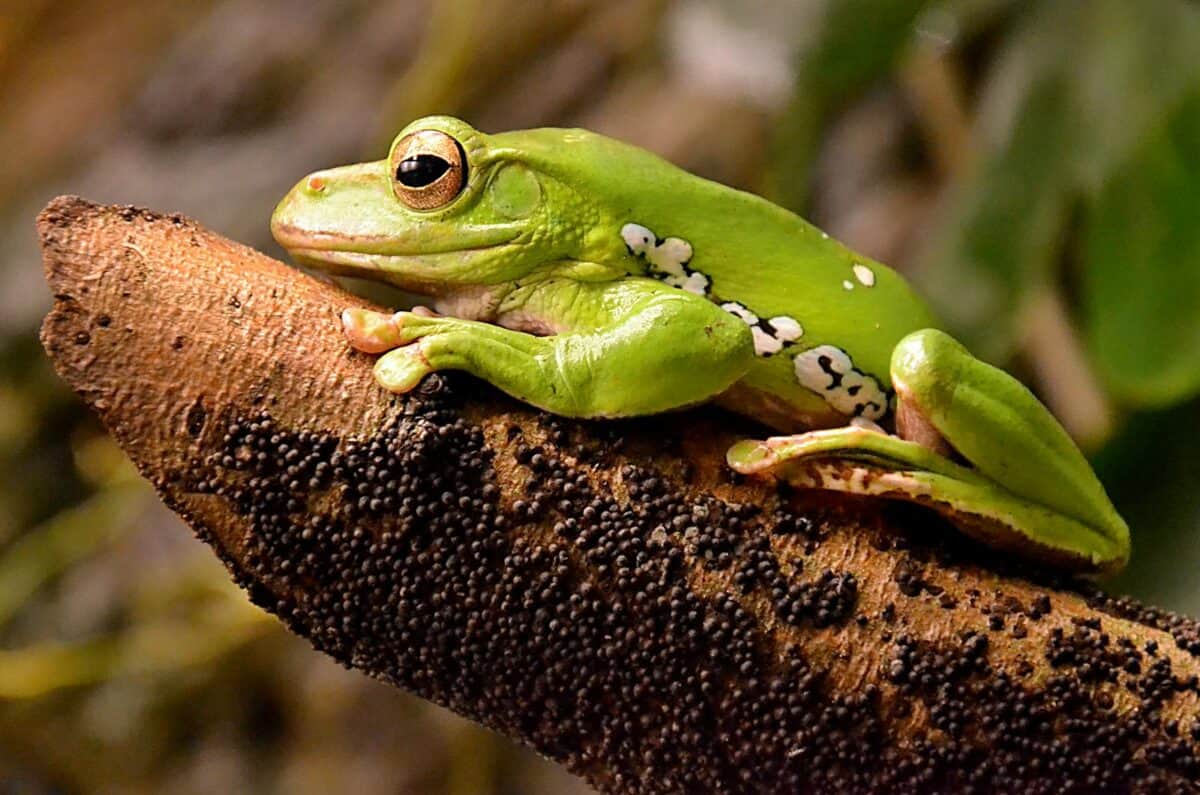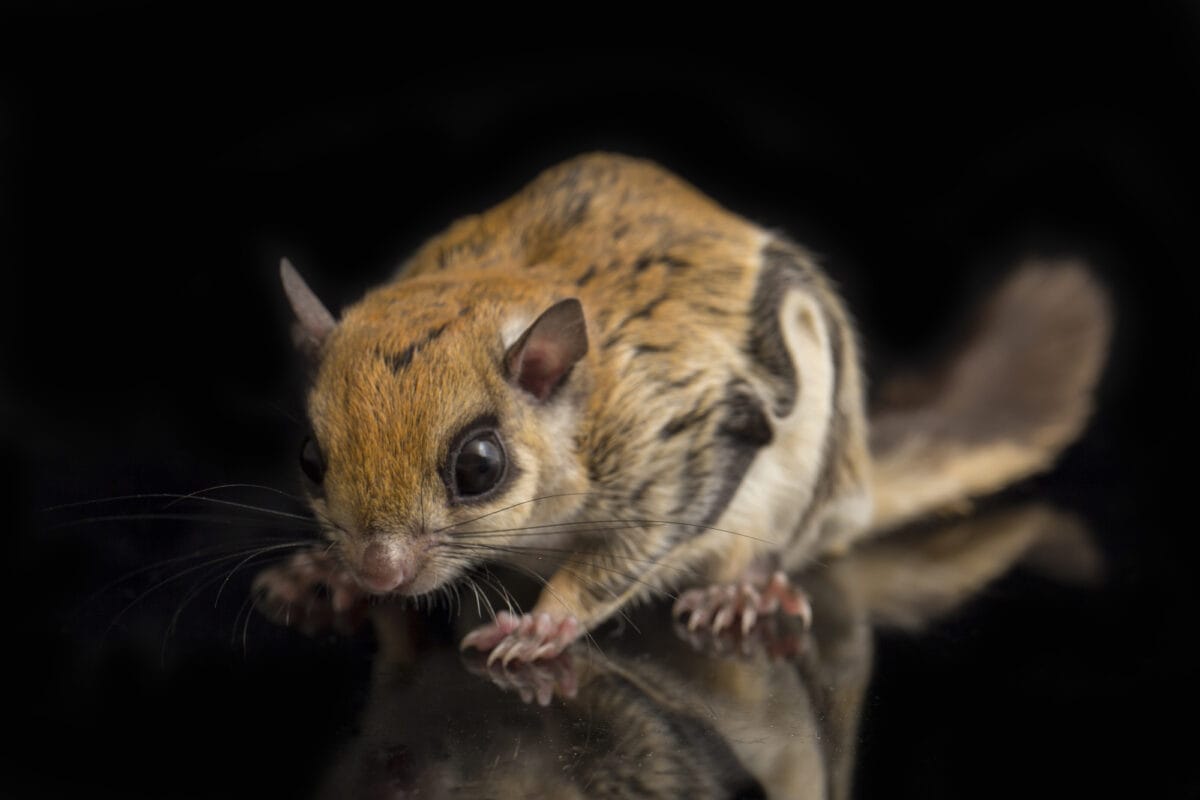When we think of flying creatures, birds typically come to mind first. However, the ability to navigate through the air isn’t exclusive to our feathered friends. Throughout evolutionary history, numerous land animals have developed remarkable adaptations enabling them to take to the skies, even if temporarily. From mammals to reptiles and even some amphibians, these fascinating creatures have evolved specialized anatomical features that allow them to glide or, in some cases, achieve powered flight. These adaptations have emerged independently across different animal groups through convergent evolution, demonstrating nature’s ingenious solutions to similar environmental challenges. Let’s explore twelve extraordinary land animals that have conquered the air in their own unique ways.
12. Southern Flying Squirrel (Glaucomys volans)

The Southern Flying Squirrel is one of the most recognizable gliding mammals in North America. Despite its name, this small rodent doesn’t actually fly but instead glides between trees using a specialized membrane called a patagium. This furry flap of skin stretches from the wrist of the front leg to the ankle of the hind leg, creating an effective airfoil when the limbs are extended. When leaping from a high point, the squirrel spreads its limbs to deploy this natural parachute, allowing it to glide distances of up to 150 feet. Their flattened tail serves as both a rudder for steering and a brake when approaching landing. These nocturnal creatures have large eyes that provide excellent night vision, enabling them to navigate safely during their aerial journeys in the darkness. Their remarkable gliding ability helps them evade predators and efficiently travel between food sources without descending to the forest floor.
11. Colugo or Flying Lemur (Dermoptera)

Despite its misleading name, the Colugo is neither a lemur nor capable of true flight. However, it possesses the most extensive gliding membrane of any mammal, making it arguably the most accomplished glider in the animal kingdom. Native to Southeast Asia, these remarkable creatures have a patagium that extends from their neck to the tips of their fingers, between their fingers, between their toes, and even includes their tail. This comprehensive gliding surface allows them to cover distances of up to 200 feet in a single glide with minimal loss of altitude. Studies have shown that colugos can achieve glide ratios of 10:1 or better, meaning they can travel ten meters horizontally for every meter of height lost. Their specialized skin membrane is so extensive that it even creates webbing between their fingers and toes, giving them a somewhat awkward appearance when climbing trees. Colugos have evolved remarkable adaptations for their arboreal lifestyle, including comb-like lower front teeth that they use for grooming their fur and membrane, and strong claws for climbing.
10. Sugar Glider (Petaurus breviceps)

The Sugar Glider is a small, nocturnal marsupial native to Australia, Indonesia, and Papua New Guinea that has become popular in the exotic pet trade due to its endearing appearance and fascinating gliding ability. Similar to flying squirrels, sugar gliders possess a patagium extending from their wrists to their ankles, allowing them to glide between trees when foraging at night. These small creatures can glide distances of up to 50 meters (approximately 164 feet) and have remarkable control during their aerial journeys. Their name derives from their preference for sweet foods like nectar and sap, though they are omnivorous and also consume insects and small vertebrates. Sugar gliders are highly social animals that live in family groups of up to seven individuals in the wild, communicating through various vocalizations and scent marking. Their tail, which is almost as long as their body, serves as a crucial counterbalance during gliding and helps with directional control. As marsupials, female sugar gliders have a pouch where their young, called joeys, develop after a very short gestation period of just 15-17 days.
9. Wallace’s Flying Frog (Rhacophorus nigropalmatus)

Named after the naturalist Alfred Russel Wallace, this remarkable amphibian is native to the rainforests of Malaysia, Indonesia, and other parts of Southeast Asia. Wallace’s Flying Frog has evolved extraordinary adaptations that enable it to glide from tree to tree, an unusual ability among amphibians. Their oversized webbed feet act as effective parachutes, significantly increasing their surface area relative to their body weight. Additionally, they have loose flaps of skin on their limbs that further enhance their gliding capability. When leaping from a high branch, these frogs spread their limbs wide, transforming their body into a living parachute that can carry them up to 50 feet horizontally. This aerial ability serves as both a predator avoidance mechanism and an efficient means of travel between trees in their canopy habitat. Unlike many other frogs that need to return to water to reproduce, Wallace’s Flying Frogs have adapted to their arboreal lifestyle by creating foam nests on leaves overhanging water bodies. When the tadpoles hatch, they fall directly into the water below, beginning their aquatic stage of development.
8. Flying Gecko (Ptychozoon)

The Flying Gecko represents one of nature’s most ingenious gliding adaptations among reptiles. These remarkable lizards, found primarily in Southeast Asian rainforests, possess extensive flaps of skin along their bodies, limbs, and tail that function similarly to the membranes of flying squirrels. When the gecko leaps from a tree, it spreads its limbs and flattens its body, allowing these skin flaps to catch air and create lift. This adaptation enables controlled descents rather than true gliding, but it still provides impressive aerial mobility. Beyond their gliding capabilities, flying geckos have evolved extraordinary camouflage that mimics tree bark, making them nearly invisible when at rest on tree trunks. Like other geckos, they possess specialized toe pads covered with microscopic hair-like structures called setae that generate van der Waals forces, allowing them to climb vertical surfaces and even walk upside down on smooth ceilings. These nocturnal reptiles primarily feed on insects and other small invertebrates they encounter during their nighttime activities. Their ability to glide between trees provides an effective escape mechanism from predators and expands their foraging range.
7. Flying Dragon Lizard (Draco volans)

The Flying Dragon Lizard embodies its mythical namesake with its remarkable ability to glide through tropical forests. Native to Southeast Asia, these small reptiles measure only about 8 inches in length but possess an extraordinary adaptation: elongated ribs that extend outward and support a membrane (patagium) that can be deployed like wings. When threatened or moving between trees, the lizard extends these modified ribs, transforming its silhouette into a wing-like shape that can carry it up to 30 meters (about 100 feet) through the air. Unlike other gliding animals that use skin membranes between limbs, Draco lizards are unique in using their ribs to support their gliding apparatus. This evolutionary adaptation allows them to keep their limbs free for landing and climbing. Males of the species have colorful throat flaps called dewlaps that they extend for territorial displays and to attract females during breeding season. These vibrant displays present a stark contrast to their otherwise cryptic coloration that blends with tree bark. Flying dragons are insectivores, primarily feeding on ants and termites they find while moving between trees in their forest habitats.
6. Malaysian Flying Frog (Rhacophorus reinwardtii)

The Malaysian Flying Frog, closely related to Wallace’s Flying Frog, is another remarkable amphibian that has evolved the ability to glide through the rainforest canopy. This vibrant green frog possesses extensive webbing between both its fingers and toes, creating effective “parachutes” that significantly slow its descent when leaping from heights. The webbing on these frogs is so extensive that it gives their feet a distinctive mitt-like appearance. When launching from a tree, they spread their limbs wide, maximizing their surface area and creating enough lift to control their trajectory through the air. They’ve been observed gliding distances of up to 15 meters (approximately 50 feet) while descending at angles of less than 45 degrees, demonstrating impressive aerial control. Like other tree frogs, they possess specialized toe pads covered with tiny structures that create friction and allow them to cling to vertical surfaces. Malaysian Flying Frogs are primarily nocturnal and spend most of their lives high in the trees, rarely descending to the forest floor except during breeding periods. Female frogs create foam nests attached to vegetation above water bodies where they deposit their eggs, and once hatched, the tadpoles drop into the water below.
5. Northern Flying Squirrel (Glaucomys sabrinus)

The Northern Flying Squirrel is the larger cousin of the Southern Flying Squirrel and inhabits coniferous and mixed forests across Canada, the northern United States, and parts of the Appalachian Mountains. Like other flying squirrels, this nocturnal rodent possesses a patagium—a furred membrane of skin that extends from wrist to ankle—which allows it to glide between trees. When leaping from a high perch, the squirrel extends its limbs to stretch this membrane taut, creating an effective airfoil that can carry it distances of up to 90 meters (almost 300 feet) in ideal conditions. Their remarkably flat, broad tail serves dual purposes: as a rudder for steering during glides and as a stabilizer upon landing. Northern Flying Squirrels have evolved several adaptations for their nocturnal lifestyle, including large eyes that provide excellent night vision and sensitive whiskers that help them navigate in the dark. Unlike many rodents, these flying squirrels don’t hibernate during winter months. Instead, they remain active year-round, though they may share nests with multiple individuals during cold periods to conserve body heat. Their diet is uniquely diverse, consisting largely of fungi (including truffles), lichens, nuts, seeds, fruits, and even insects. Research has revealed that these squirrels play a crucial ecological role in forest ecosystems by dispersing the spores of mycorrhizal fungi that form beneficial relationships with tree roots.
4. Paradise Flying Snake (Chrysopelea paradise)

Perhaps the most surprising animal on this list, the Paradise Flying Snake demonstrates that even limbless reptiles can achieve remarkable aerial mobility. Native to Southeast Asia, this slender tree snake has perfected a unique method of gliding that defies expectations. When ready to launch, the snake climbs to a high branch, dangles its body in a J-shape, and then propels itself into the air with a powerful thrust. Once airborne, it flattens its entire body by spreading its ribs and pulling in its ventral surface, creating a concave shape that generates lift much like an airplane wing. Most remarkably, the snake performs undulating S-shaped movements in the air, which stabilizes its flight path and may even generate additional lift. Studies have documented these snakes gliding distances of up to 100 meters (around 330 feet) and even making turns mid-air to navigate toward specific targets. Despite their intimidating name and ability, Paradise Flying Snakes are non-venomous to humans, though they are mildly venomous to their prey, which consists primarily of lizards, frogs, birds, and bats. Their vibrant green coloration with black stripes serves as effective camouflage in their forest habitat, helping them ambush prey and avoid predators.
3. Sunda Flying Lemur (Galeopterus variegatus)

The Sunda Flying Lemur, or Sunda Colugo, is the second species in the Dermoptera order alongside the Philippine Colugo. Despite being called “flying lemurs,” these animals neither fly nor are they lemurs—they belong to their own distinct mammalian order. Native to the rainforests of Southeast Asia, including Indonesia, Thailand, Malaysia, and Singapore, the Sunda Colugo possesses the most extensive gliding membrane of any mammal. This patagium extends from the neck to the fingertips, between fingers, between toes, and all the way to the tip of the tail, essentially enveloping the entire animal except for its head. When fully extended, this membrane creates an almost square gliding surface that allows these mammals to cover distances of up to 100 meters (about 330 feet) while losing minimal altitude. Research has shown they can achieve remarkable glide ratios exceeding 12:1. Sunda Colugos are strictly herbivorous, feeding primarily on leaves, shoots, flowers, sap, and fruits. They are primarily nocturnal, spending their days clinging motionless to tree trunks where their mottled gray-brown fur provides excellent camouflage against bark and lichen. Female colugos typically give birth to a single offspring after a 60-day gestation period. The young cling to their mother’s belly, hidden beneath the gliding membrane that folds into a built-in baby pouch, and may even join her on gliding journeys.
2. Gliding Ant (Cephalotes atratus)

The Gliding Ant represents one of the most fascinating examples of aerial adaptation in the insect world. These remarkable canopy-dwelling ants, native to the rainforests of South America, have evolved a unique ability to control their descent when falling from the high canopy. Unlike other gliding animals that use membranes or specialized limbs, Cephalotes atratus ants utilize their flattened head, thorax, and legs to create aerodynamic surfaces. When knocked or dropped from a tree, rather than tumbling helplessly to the ground, these ants spread their legs and adjust their body position to generate lift and maneuver in mid-air. Researchers studying this behavior discovered that these ants can actually direct their descent back toward the tree trunk, allowing them to reconnect with their home tree rather than landing on the forest floor where they would face increased predation risks and long journeys back to their colony. This controlled aerial ability is called directed aerial descent (DAD) and can be so precise that ants can land on the exact same tree trunk they fell from, even after dropping from heights of 30 meters (approximately 100 feet). Their unique flattened morphology that makes this gliding possible also serves as excellent camouflage against the bark of trees where they forage. These specialized ants are sometimes called “turtle ants” due to their flattened shape and hard exoskeleton that protects them from predators.
1. Ballooning Spiders (Various Species)

While not technically flying or gliding in the traditional sense, numerous spider species have evolved a remarkable method of aerial dispersal called “ballooning” that deserves mention among land animals capable of aerial movement. This behavior is particularly common among spiderlings (young spiders) as a mechanism for dispersal, though some adult spiders of smaller species also employ this technique. To become airborne, a ballooning spider climbs to an elevated position, points its abdomen toward the sky, and releases several strands of silk into the air. These silk threads, which can extend several meters in length, catch air currents and eventually generate enough lift to carry the spider aloft. Once airborne, spiders have minimal control over their direction but can influence when they descend by reeling in or releasing more silk. This passive flight mechanism has enabled spiders to become among the first colonizers of new terrains, including volcanic islands that have recently emerged. Remarkably, ballooning spiders have been detected in atmospheric samples collected by aircraft at altitudes exceeding 4,000 meters (13,000 feet), and they have been documented traveling hundreds of kilometers over open ocean. Recent research suggests that beyond simply catching the wind, spider silk may interact with Earth’s electric field, potentially providing additional lift during the ballooning process. This extraordinary adaptation has contributed significantly to the global distribution of spiders across nearly every terrestrial habitat.
Conclusion: The Evolutionary Marvel of Aerial Adaptations

The diverse array of land animals that have conquered the air through flight or gliding represents one of evolution’s most fascinating examples of convergent adaptation. From mammals like flying squirrels and colugos to reptiles such as flying geckos and paradise flying snakes, these animals have independently evolved solutions to the challenges of three-dimensional movement through forest canopies. These aerial adaptations serve multiple purposes: efficient locomotion between trees, predator avoidance, expanded foraging opportunities, and in some cases, reduced energy expenditure compared to climbing down and back up trees. Many of these remarkable gliding species face increasing threats due to deforestation and habitat fragmentation, making conservation efforts critical
- 10 Reptiles That Walked With Dinosaurs - August 21, 2025
- 15 Most Colorful Creatures Found in U.S. Waters - August 21, 2025
- 11 Animals Found Frozen in Ice - August 21, 2025

